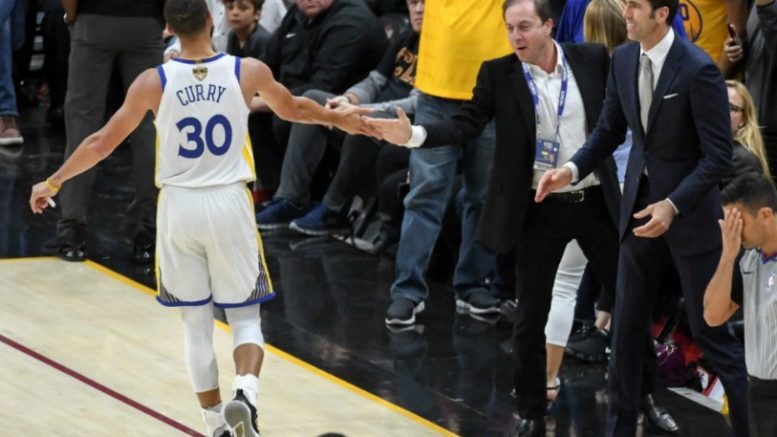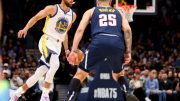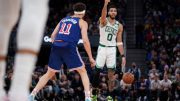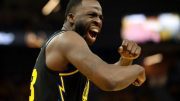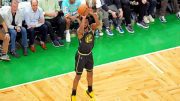The Golden State Warriors are currently over the salary ceiling by $71 million and over the luxury tax threshold by $39 million.
According to Spotrac, their expected luxury tax payment this offseason will be a touch over $170 million as a repeat taxpayer.
That’s virtually the same as the $175 million they’re paying their roster, so Golden State will be on the hook for almost $346 million this season.
Because of that willingness to spend, the Warriors are one win away from a championship. However, some are spreading sour grapes about Golden State’s investment.
ESPN’s Brian Windhorst is the most recent example, but ESPN’s Zach Lowe has written about NBA owners “grumbling” about the Warriors’ spending advantage in a market where they have become one of the most valuable franchises in the league.
From the outside looking in, the scene appears to be one of a squad that is “buying” championships. The Golden State Game 5 victory, according to Windhorst, was a “checkbook win.”
This could hardly be more untrue. Golden State has developed a title-contending squad, and they’ve done everything a club should try to do to stay competitive.
The Warriors have made some difficult decisions
In his ESPN essay, Lowe discusses the conditions surrounding the 2019 NBA offseason, including Warriors General Manager Bob Myers’ decision to trade Andre Iguodala and his huge contract to the Memphis Grizzlies in exchange for a top-four protected 2024 first-round pick. According to Steve Kerr, who is cited as saying:
“That [Iguodala] trade was a great example of why the coach should not be the general manager,” Kerr says. “If I had been in charge, I wouldn’t have done the deal, and we wouldn’t be sitting here with Andrew Wiggins and [Jonathan] Kuminga.”
Of course, before Wiggins and Kuminga could become Warriors, Golden State had to make a deal or two—first with the D’Angelo Russell trade, which turned into a double sign and trade with the Brooklyn Nets involving the departing Kevin Durant, and then with the move to bring in Wiggins—then regarded as a failed No. 1 overall pick by impact standards—and the pick that eventually became Kuminga (and a second-rounder for Jacob Evans and Omari Spellman to help the Warriors get under the tax).
As Lowe points out, he was not involved in the Warriors’ No. 28 choice in the 2019 draft, and as Lowe points out, he was not involved in Wiggins’ 2020 transactions. Back then, he was fighting for playing time at a terrible club – how things can change in only a few years.
The Warriors had to make some painful decisions early in their dynasty’s rise to move on from crucial players, and they needed stars like Steph Curry to understand and not rock the boat while those decisions were made. More than what they can spend, the signings and astute roster management decisions have them on the verge of history.
The same may be true for what they do once they’ve enlisted their services.
The Warriors develop, and pay, their own
Hundreds of millions of dollars have been spent on Golden State’s own players. Steph Curry, Klay Thompson, and Draymond Green are all past Warriors draft picks, but their dedication to their style of play and the people they’ve brought in to help them improve it is impressive.
The Warriors are owed over $176 million this season, including roughly $135 million in players that Golden State either drafted or has spent the majority of their careers with (201 of Damion Lee’s 2016 games were played with the Warriors).
That amounts to nearly 77 percent of the Warriors’ payroll being spent in a way that, in principle, the NBA should support—on local players deemed worthy of investment by the Warriors’ head management.
The finger is thrown at Andrew Wiggins as the cause of Golden State’s triumph on Monday, which represents the team’s financial power more than anything else. After all, he (together with Kuminga) is the end product of Golden State’s massive cap hike in the summer of 2016, when they signed Kevin Durant.
Durant, of course, was instrumental in the Warriors’ dynasty, but once KD decided to leave, Golden State landed Wiggins thanks to a double sign-and-trade with Russell.
If Durant hadn’t agreed to the deal, he wouldn’t have been able to have a career night for the Warriors in Game 5 against the Boston Celtics. This was a deal that Brooklyn didn’t have to make, but they did because they got a draft pick in return.
Revisit the Wiggins trade — in addition to Wiggins, Golden State received a first-round pick, which eventually became Jonathan Kuminga at No. 7 overall. Andrew Wiggins was not viewed as a super-talent who could help the team extend its championship window.
He was viewed as a bigger winger who could perhaps defend and serve as a good third-or fourth-option, or as yet another big contract that Myers and the Warriors could trade for a “true” star in exchange for a pick or two.
On Monday night, Wiggins shone brightly, assisting the Warriors in a game in which Stephen Curry failed to make a three-pointer for the first time in 233 games. Kevin Durant’s stat line of 26 points, 13 rebounds, and 43 minutes played in a vital Game 5 win in San Francisco would have been legendary in his prime.
But it was Wiggins, the man Minnesota didn’t want and was willing to give up a lottery pick to bring in D’Angelo Russell, who made the biggest difference.
Russell is a contentious figure for the Timberwolves, and he’s reported to be available for trade. If not for Steph Curry’s brilliance, he would have been the Finals MVP if Golden State won this series because of his ability to score and stop Boston’s finest offensive weapons.
This has to do with the Warriors’ talent-development culture. Not just the athletes they’ve drafted or signed, but also those who arrive with baggage and grow into something greater. The team’s commitment to being consistent in their own trade conversations and committed to their sense of what Wiggins could be in their system is paying off now, and Wiggins is the best proof of that yet.
Follow in the footsteps of others
Joe Lacob, the Golden State Warriors’ managing owner, is estimated to be worth $1.2 billion. That puts him in 24th place among current NBA owners. As the head of his investment firm, Lacob has a 25% stake in the Warriors, which is worth almost $1 billion right now.
This means that his $115 million investment in the team in 2010 has grown by almost a factor of ten in the last 12 years.
Having generational talent will help, but Lacob and his club have always been prepared to spend whatever it takes to maintain a competitive product on the floor when the team has been able to compete.
And Warriors general manager Bob Myers has done an excellent job of keeping the Warriors under the luxury tax during their recent downturn due to Klay Thompson’s injury, and then back above it when the time came to reengage with their dynastic destiny.
Lacob isn’t anywhere close to being the NBA’s wealthiest controlling owner. Owners should study how he and Golden State got here instead of moaning about how they did it.
They should try to model their clubs after them. Again, easier said than done—it all starts with securing talent in the NBA Draft, which may be a lottery if a team isn’t totally committed to a scheme or system and the type of player needed to carry it out.
But Andrew Wiggins, who is regarded as Golden State’s third-most essential player, is the only “vital” Warriors player who was a former No. 1 pick.
You can see how the Warriors spotted it, groomed it, fostered it, and then invested in it when the time came on multiple draft boards. As a result, a franchise that many felt would never return to the top of the NBA mountain is likely to do so.
There are already teams with exceptional quality and youthful vigor in place to be the “next” Golden State.
The owners of the Pelicans and Grizzlies are both wealthier than Lacob, and the Celtics’ owner has a team that is both historically significant and now among the best in the NBA, as they try to block Golden State from their fairytale ending.
This type of accomplishment is possible for anyone, whether it is one of those three or someone else. The focus should therefore be on how much it should cost to get there, rather than how much it should cost to get there.
It should be based on how much you’re willing to put into the process to not only get to the top, but to stay there.

